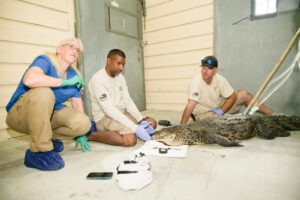“For now, they’re riding this wave and trying to recoup what they lost during the pandemic closures. It’s not that they’re being greedy, but as a business you don’t want to leave money on the table when people are willing to pay it, and are filling these rooms.” — Jodi Weinhofer, president, Lodging Association of The Florida Keys & Key West
$1,416. $1,143. $1,398.
Those aren’t monthly rents or mortgage payments. They’re nightly room rates at Florida Keys hotels for the Memorial Day weekend, according to prices listed this week on Expedia.com, which don’t include the additional daily resort and parking fees that typically add about $40 per night to published room rates.
As of May 6, Key West hotel prices were the highest in the country, with Islamorada and Marathon filling the No. 2 and 3 slots, according to a survey by cheaphotels.org that included all hotels rated three or more stars in destinations all over the country that were either near a beach or an urban center.
In Islamorada, prices for weekend stays were as high as $1,009 a night at one resort, while others’ rates were $1,003 and $766 per night.
In Marathon, hotel room rates have increased by nearly 50% based on a Google search of accommodations in the Middle Keys when compared to tourist reports from 2019 during the month of May. In 2019, the average room rate in the Middle Keys was $230; now it’s up to about $336. On holiday weekends, the prices are even higher. Two waterfront, luxury resorts are advertising rooms for Saturday, May 29 for $935 and $829. National brand, mid-level hotels are going for about $650 for one night over the Memorial Day weekend.
And yes, plenty of people are paying those prices.
“Our occupancy is way beyond where it should be right now,” Jodi Weinhofer, president of the Lodging Association of the Florida Keys & Key West, told the Keys Weekly on Tuesday. “But as soon as occupancy drops, hotels will lower their rates. For now, they’re riding this wave and trying to recoup what they lost during the pandemic closures. It’s not that they’re being greedy, but as a business you don’t want to leave money on the table when people are willing to pay it, and are filling these rooms.”
The entire Florida Keys island chain is experiencing an unprecedented number of visitors, demand for lodging and willingness to pay the equivalent of a month’s rent in most cities for a single night in Key West or Islamorada.
But throughout the state and nation, staffing shortages are also unprecedented, prompting many in the hospitality and leisure industries to ask: What do these visitors get when they arrive? And could the sky-high hotel rates backfire on a destination when visitors don’t get the service they expect for the price they paid to be here?
Stacey Mitchell, director of the Monroe County Tourist Development Council (TDC), is asking — and trying to answer — the same questions.
“There is such pent-up demand for people to get away, wherever they can go, and a lot of people have an unparalleled amount of savings right now, whether it’s from stimulus money, or from not spending it on other trips for the past year and a half,” Mitchell said.
“Visitors are willing to overlook many shortcomings in terms of service and places being short-staffed,” Mitchell said.
“That tolerance will only last so long. We are forecasting a future where value for price paid, and services commensurate with the price point, will be instrumental in maintaining our market share and the integrity of our brand,” Mitchell wrote in a recent report to Keys tourism officials.
In other words, people won’t always be willing to overlook our shortcomings in service, in a location for which they’ve paid dearly, and will soon expect to get what they paid for.
“There’s no doubt that throughout Florida and nationally, the travel and tourism industry is struggling to meet the needs of this sudden and unprecedented boom in business,” said Mitchell, who just returned from a tourism conference at a hotel in St. Augustine Beach.
The host hotel, whose brand is known for its included breakfasts and nightly manager’s happy hour, was not offering those services.
“They just don’t have the staff,” she said.
Jodi Weinhofer, president of the Lodging Association of the Florida Keys & Key West, has heard of all the same staffing challenges — and the same disbelief about exorbitant room rates.
“We have general managers cleaning rooms so they can check people in,” Weinhofer said. “And I’ve had general managers and front desk managers say they’re embarrassed to tell people their nightly room rates.
“But they’ve all been warned, and they already knew, this won’t last,” Weinhofer said, adding that once the Caribbean, Mexico and Europe reopen and once cruise ships start sailing again throughout the world, the demand, and prices, will drop significantly.
“The hotel industry is second only to the airline industry when it comes to reacting quickly to the marketplace,” she said. “The minute their occupancy drops, their rates will drop. But right now, our occupancy numbers are way beyond where they should be. And it’s not just Key West. For the first time ever, Islamorada’s average daily hotel room rate was higher than Key West’s last week.
“I think everyone figures this will be over by the end of summer, and they’re just riding the wave now, while people are willing to pay these rates, to get out of the hole they were in at the height of the pandemic, when no one was going anywhere,” Weinhofer said.
But are visitors complaining when they pay $800 per night at a chain hotel that’s usually affordable, and then don’t get daily housekeeping service in their room, or the free hot breakfast in the lobby?
“I won’t lie. I think there are definitely some complaints, and I’m sure some brands are getting hammered, especially by their VIP members who accumulate points each stay,” Weinhofer said. “But the same things are happening everywhere, and I do think most properties are doing a good job of letting people know they’re short-staffed and explaining the situation.”
Where are the workers?
The staffing shortages prompt yet another question: Why?
Why is it so much more difficult to find workers now than it was before COVID struck?
There are many theories and targets.
Earlier this week, Gov. Ron DeSantis announced Florida will end its participation in the Federal Pandemic Unemployment Compensation program, the $300 per week supplemental payment, effective June 26. Many business owners are blaming the government’s unemployment benefits for making it more profitable for many workers to stay home than go to work.
And that is the case in many situations.
“Why would you expose yourself to the risks of working in close quarters, serving people food and drinks, when you could just make more money on unemployment?” one longtime restaurant employee, who asked that his name not be used, for fear of hurting his future employment prospects, told NPR for a May 5 article about the national worker shortages.
But Daniel Costa, an immigration researcher at the Economic Policy Institute, a liberal-leaning think tank, said in the same article, “if people are doing better on unemployment, it only means they were underpaid to start with.”
“I think we should take what (businesses) say with a grain of salt,” Costa told NPR. “Every time you hear ‘I can’t find any workers,’ you should add to the end of that – ‘at the wage I want to pay,’ because you’re talking about some very low-wage jobs.”
Travel restrictions and visa processing delays for seasonal foreign workers also are contributing to the staffing shortages, especially in summer resort towns that depend on such workers.
“Work at U.S. embassies and consulates is still ‘severely’ slow, because of pandemic restrictions, according to a State Department official, and J-1 and H-2B visas are at the bottom of the priority list,” NPR reports.
This list shows the 20 priciest destinations for U.S. hotels this spring, according to cheaphotels.org. The rates shown reflect the average price for each destination’s most affordable double room available between May 1-31, 2021.
- Key West (FL) $299
- Islamorada (FL) $295
- Marathon (FL) $285
- Poipu (HI) $245
- Sanibel Isl. (FL) $243
- Sedona (AZ) $235
- Tybee Isl.(GA) $224
- Wailea (HI) $212
- Lahaina (HI) $194
- Waikoloa (HI) $192
- Anna Maria Isl. (FL) $187
- Napa (CA) $185
- Calistoga (CA) $175
- Sarasota (CA) $172
- Santa Monica (CA) $170
- Newport (RI) $165
- Fort Myers Beach (FL) $165
- Key Largo (FL) $164
- St. Pete Beach (FL) $157
- Charleston (SC) $156


























